Human Resource Management Report: Resourcing Skills at ALDI
VerifiedAdded on 2020/06/06
|13
|3613
|38
Report
AI Summary
This report provides a comprehensive overview of Human Resource Management (HRM) within the context of a business firm, using ALDI as a case study. It begins by defining HRM and its core functions, including recruitment, training, and employee relations, emphasizing their role in enhancing productivity and organizational development. The report delves into different approaches to recruitment and selection, highlighting the strengths and weaknesses of various methods such as interviews and aptitude tests. It also explores the benefits of implementing effective HRM practices like training, reward systems, and flexible working options, as well as the link between motivational theories and rewards. Furthermore, the report examines the effectiveness of HRM practices and analyzes the impact of legal and regulatory frameworks, technological advancements, and labor market trends. It covers workforce planning, PESTLE analysis, and the importance of employee relations. The report concludes by discussing key elements of employment legislation and their implications for HRM. This report is designed to provide students with a clear understanding of HRM principles and practices, and it offers valuable insights for anyone studying business and management.
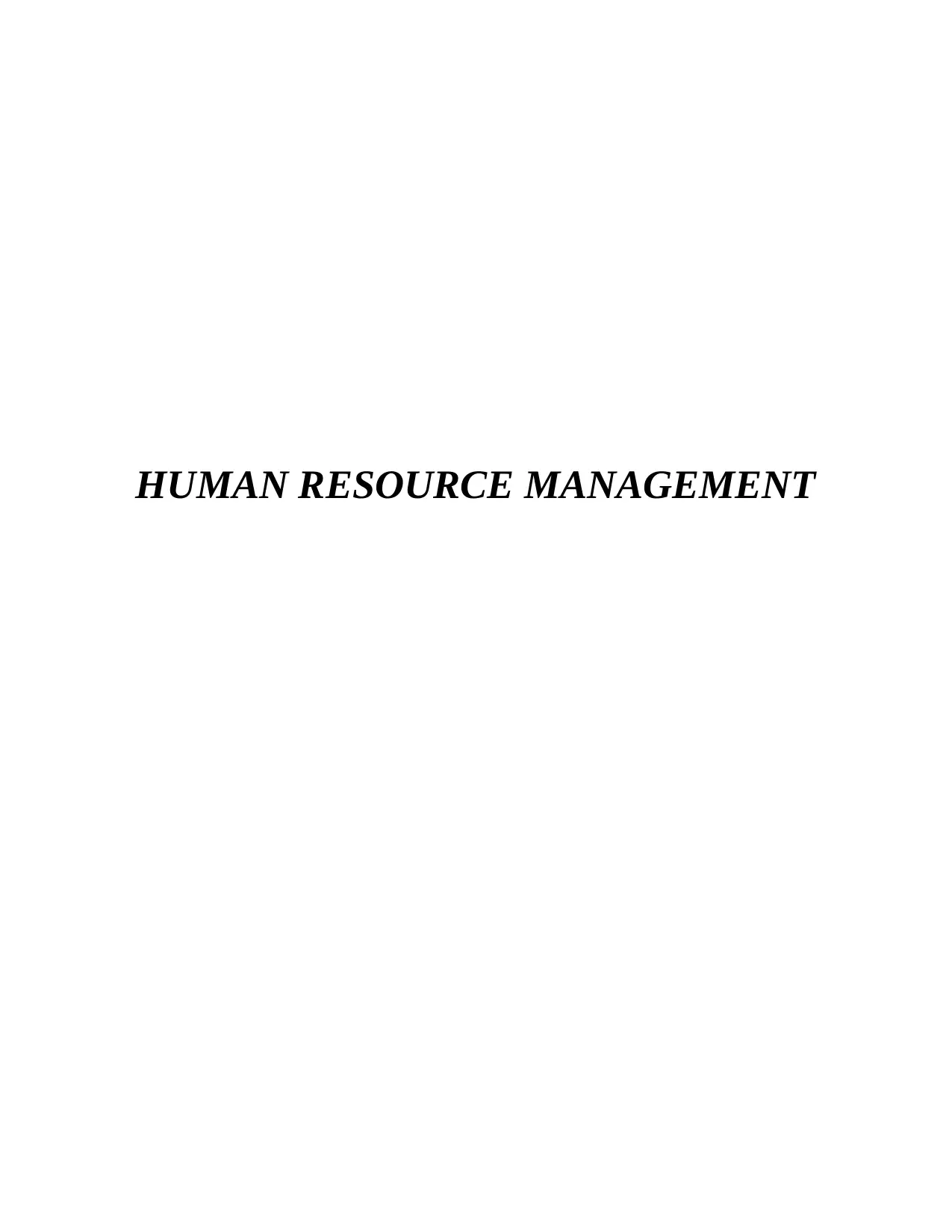
HUMAN RESOURCE MANAGEMENT
Paraphrase This Document
Need a fresh take? Get an instant paraphrase of this document with our AI Paraphraser
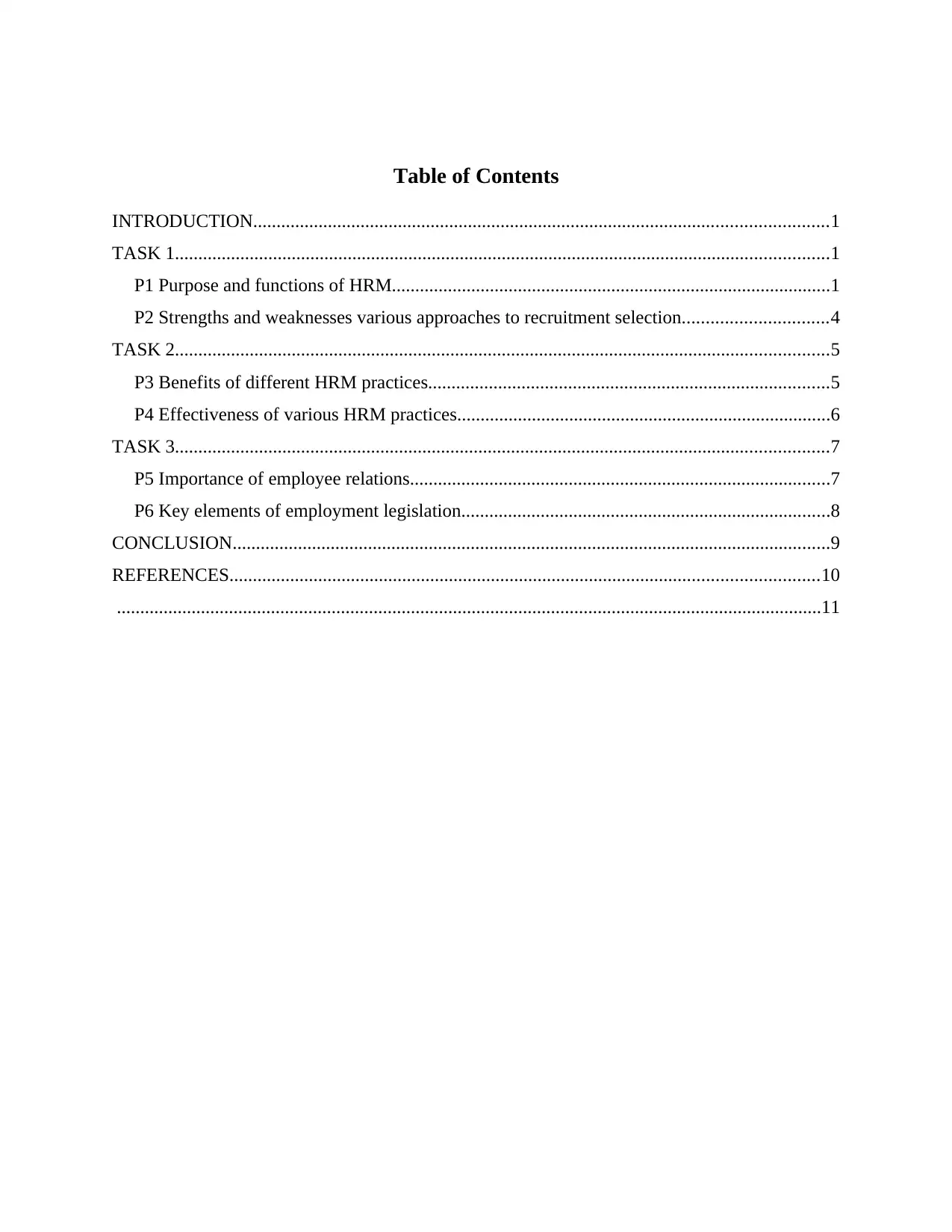
Table of Contents
INTRODUCTION...........................................................................................................................1
TASK 1............................................................................................................................................1
P1 Purpose and functions of HRM..............................................................................................1
P2 Strengths and weaknesses various approaches to recruitment selection...............................4
TASK 2............................................................................................................................................5
P3 Benefits of different HRM practices......................................................................................5
P4 Effectiveness of various HRM practices................................................................................6
TASK 3............................................................................................................................................7
P5 Importance of employee relations..........................................................................................7
P6 Key elements of employment legislation...............................................................................8
CONCLUSION................................................................................................................................9
REFERENCES..............................................................................................................................10
.......................................................................................................................................................11
INTRODUCTION...........................................................................................................................1
TASK 1............................................................................................................................................1
P1 Purpose and functions of HRM..............................................................................................1
P2 Strengths and weaknesses various approaches to recruitment selection...............................4
TASK 2............................................................................................................................................5
P3 Benefits of different HRM practices......................................................................................5
P4 Effectiveness of various HRM practices................................................................................6
TASK 3............................................................................................................................................7
P5 Importance of employee relations..........................................................................................7
P6 Key elements of employment legislation...............................................................................8
CONCLUSION................................................................................................................................9
REFERENCES..............................................................................................................................10
.......................................................................................................................................................11
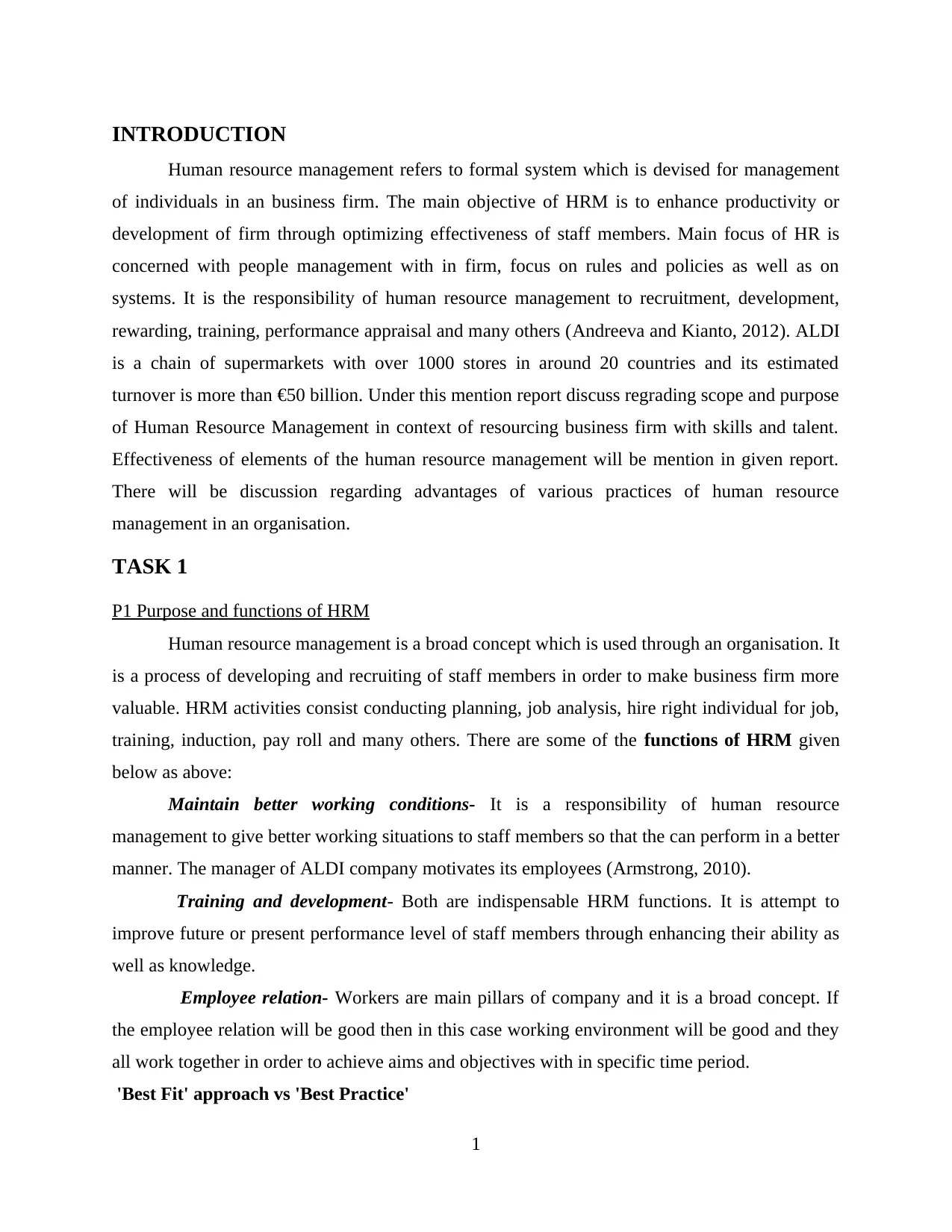
INTRODUCTION
Human resource management refers to formal system which is devised for management
of individuals in an business firm. The main objective of HRM is to enhance productivity or
development of firm through optimizing effectiveness of staff members. Main focus of HR is
concerned with people management with in firm, focus on rules and policies as well as on
systems. It is the responsibility of human resource management to recruitment, development,
rewarding, training, performance appraisal and many others (Andreeva and Kianto, 2012). ALDI
is a chain of supermarkets with over 1000 stores in around 20 countries and its estimated
turnover is more than €50 billion. Under this mention report discuss regrading scope and purpose
of Human Resource Management in context of resourcing business firm with skills and talent.
Effectiveness of elements of the human resource management will be mention in given report.
There will be discussion regarding advantages of various practices of human resource
management in an organisation.
TASK 1
P1 Purpose and functions of HRM
Human resource management is a broad concept which is used through an organisation. It
is a process of developing and recruiting of staff members in order to make business firm more
valuable. HRM activities consist conducting planning, job analysis, hire right individual for job,
training, induction, pay roll and many others. There are some of the functions of HRM given
below as above:
Maintain better working conditions- It is a responsibility of human resource
management to give better working situations to staff members so that the can perform in a better
manner. The manager of ALDI company motivates its employees (Armstrong, 2010).
Training and development- Both are indispensable HRM functions. It is attempt to
improve future or present performance level of staff members through enhancing their ability as
well as knowledge.
Employee relation- Workers are main pillars of company and it is a broad concept. If
the employee relation will be good then in this case working environment will be good and they
all work together in order to achieve aims and objectives with in specific time period.
'Best Fit' approach vs 'Best Practice'
1
Human resource management refers to formal system which is devised for management
of individuals in an business firm. The main objective of HRM is to enhance productivity or
development of firm through optimizing effectiveness of staff members. Main focus of HR is
concerned with people management with in firm, focus on rules and policies as well as on
systems. It is the responsibility of human resource management to recruitment, development,
rewarding, training, performance appraisal and many others (Andreeva and Kianto, 2012). ALDI
is a chain of supermarkets with over 1000 stores in around 20 countries and its estimated
turnover is more than €50 billion. Under this mention report discuss regrading scope and purpose
of Human Resource Management in context of resourcing business firm with skills and talent.
Effectiveness of elements of the human resource management will be mention in given report.
There will be discussion regarding advantages of various practices of human resource
management in an organisation.
TASK 1
P1 Purpose and functions of HRM
Human resource management is a broad concept which is used through an organisation. It
is a process of developing and recruiting of staff members in order to make business firm more
valuable. HRM activities consist conducting planning, job analysis, hire right individual for job,
training, induction, pay roll and many others. There are some of the functions of HRM given
below as above:
Maintain better working conditions- It is a responsibility of human resource
management to give better working situations to staff members so that the can perform in a better
manner. The manager of ALDI company motivates its employees (Armstrong, 2010).
Training and development- Both are indispensable HRM functions. It is attempt to
improve future or present performance level of staff members through enhancing their ability as
well as knowledge.
Employee relation- Workers are main pillars of company and it is a broad concept. If
the employee relation will be good then in this case working environment will be good and they
all work together in order to achieve aims and objectives with in specific time period.
'Best Fit' approach vs 'Best Practice'
1
⊘ This is a preview!⊘
Do you want full access?
Subscribe today to unlock all pages.

Trusted by 1+ million students worldwide
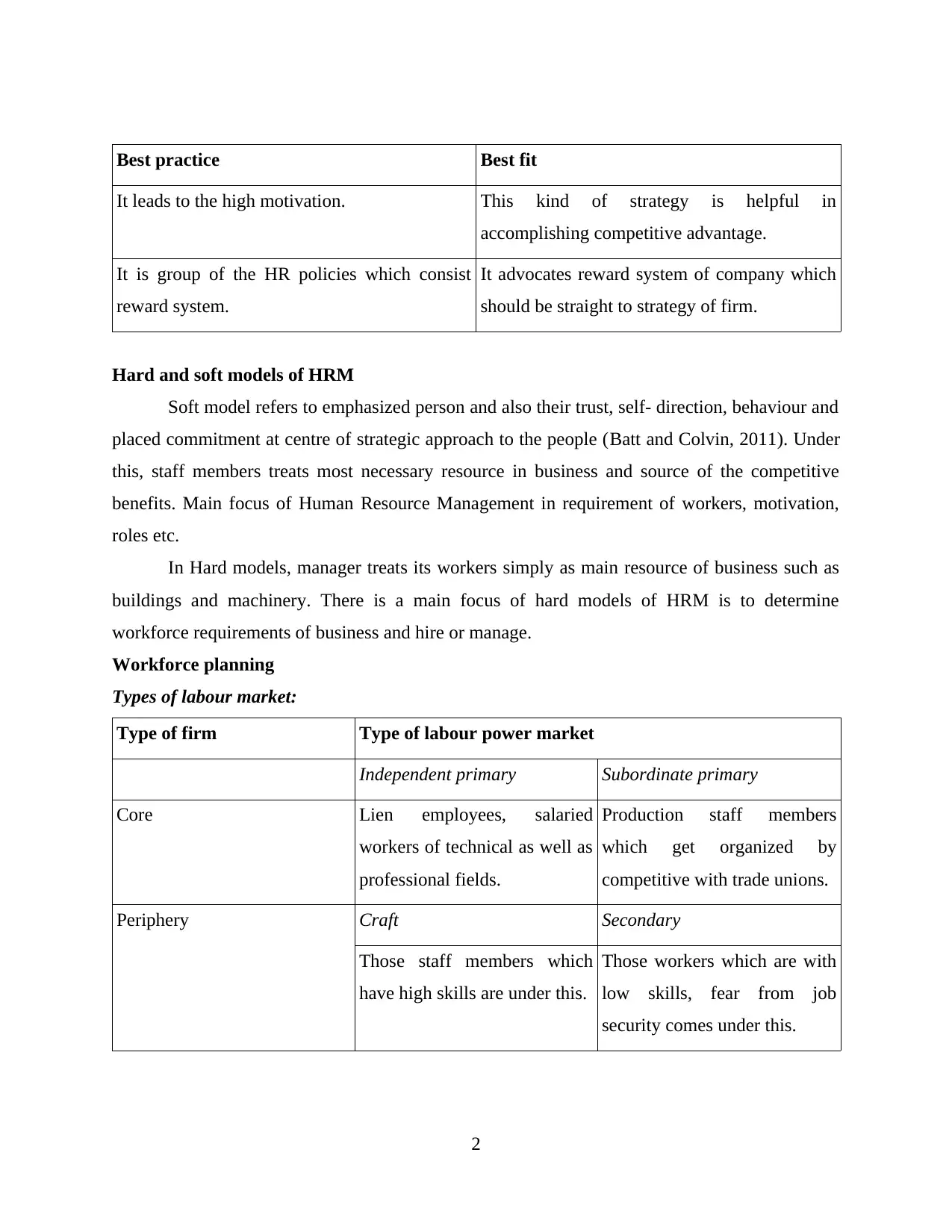
Best practice Best fit
It leads to the high motivation. This kind of strategy is helpful in
accomplishing competitive advantage.
It is group of the HR policies which consist
reward system.
It advocates reward system of company which
should be straight to strategy of firm.
Hard and soft models of HRM
Soft model refers to emphasized person and also their trust, self- direction, behaviour and
placed commitment at centre of strategic approach to the people (Batt and Colvin, 2011). Under
this, staff members treats most necessary resource in business and source of the competitive
benefits. Main focus of Human Resource Management in requirement of workers, motivation,
roles etc.
In Hard models, manager treats its workers simply as main resource of business such as
buildings and machinery. There is a main focus of hard models of HRM is to determine
workforce requirements of business and hire or manage.
Workforce planning
Types of labour market:
Type of firm Type of labour power market
Independent primary Subordinate primary
Core Lien employees, salaried
workers of technical as well as
professional fields.
Production staff members
which get organized by
competitive with trade unions.
Periphery Craft Secondary
Those staff members which
have high skills are under this.
Those workers which are with
low skills, fear from job
security comes under this.
2
It leads to the high motivation. This kind of strategy is helpful in
accomplishing competitive advantage.
It is group of the HR policies which consist
reward system.
It advocates reward system of company which
should be straight to strategy of firm.
Hard and soft models of HRM
Soft model refers to emphasized person and also their trust, self- direction, behaviour and
placed commitment at centre of strategic approach to the people (Batt and Colvin, 2011). Under
this, staff members treats most necessary resource in business and source of the competitive
benefits. Main focus of Human Resource Management in requirement of workers, motivation,
roles etc.
In Hard models, manager treats its workers simply as main resource of business such as
buildings and machinery. There is a main focus of hard models of HRM is to determine
workforce requirements of business and hire or manage.
Workforce planning
Types of labour market:
Type of firm Type of labour power market
Independent primary Subordinate primary
Core Lien employees, salaried
workers of technical as well as
professional fields.
Production staff members
which get organized by
competitive with trade unions.
Periphery Craft Secondary
Those staff members which
have high skills are under this.
Those workers which are with
low skills, fear from job
security comes under this.
2
Paraphrase This Document
Need a fresh take? Get an instant paraphrase of this document with our AI Paraphraser
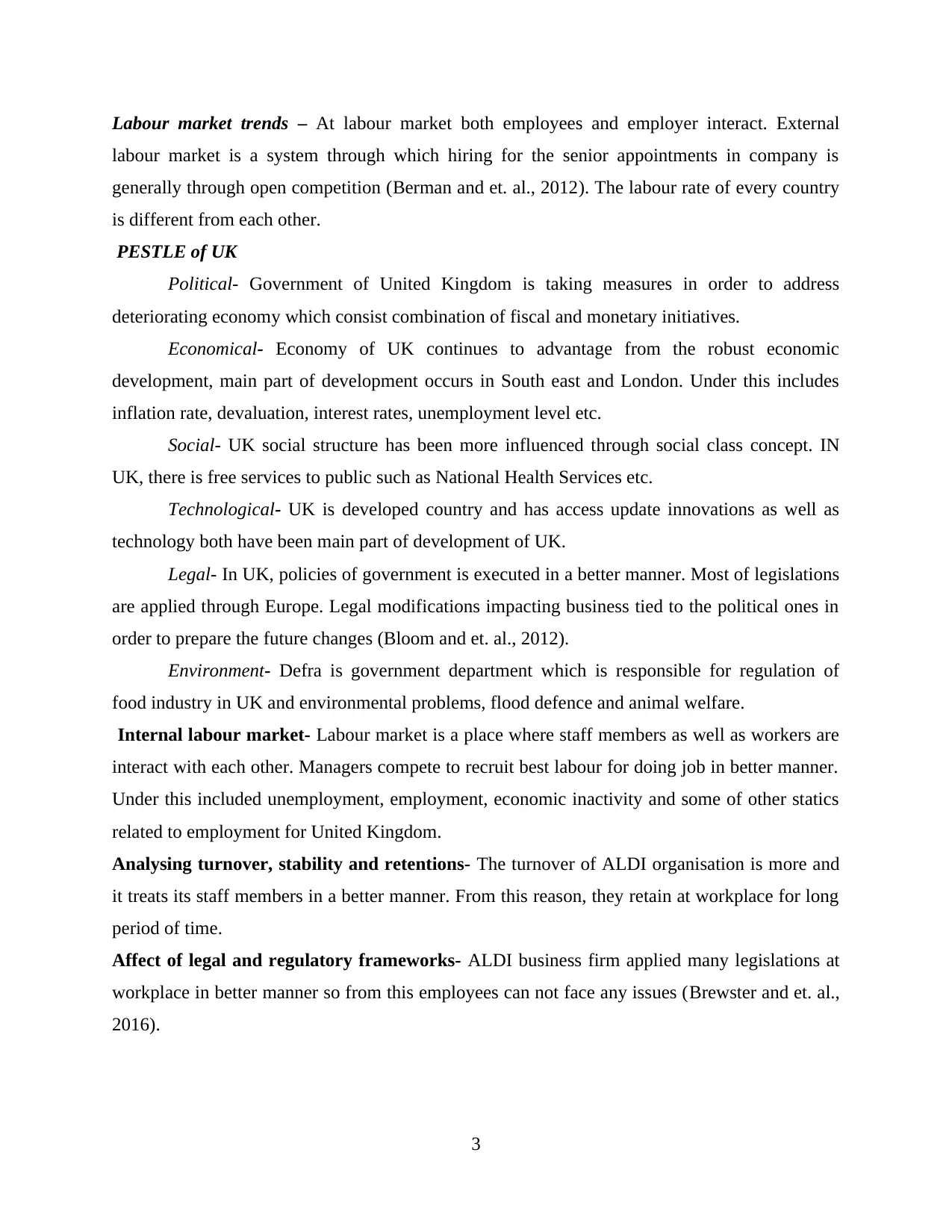
Labour market trends – At labour market both employees and employer interact. External
labour market is a system through which hiring for the senior appointments in company is
generally through open competition (Berman and et. al., 2012). The labour rate of every country
is different from each other.
PESTLE of UK
Political- Government of United Kingdom is taking measures in order to address
deteriorating economy which consist combination of fiscal and monetary initiatives.
Economical- Economy of UK continues to advantage from the robust economic
development, main part of development occurs in South east and London. Under this includes
inflation rate, devaluation, interest rates, unemployment level etc.
Social- UK social structure has been more influenced through social class concept. IN
UK, there is free services to public such as National Health Services etc.
Technological- UK is developed country and has access update innovations as well as
technology both have been main part of development of UK.
Legal- In UK, policies of government is executed in a better manner. Most of legislations
are applied through Europe. Legal modifications impacting business tied to the political ones in
order to prepare the future changes (Bloom and et. al., 2012).
Environment- Defra is government department which is responsible for regulation of
food industry in UK and environmental problems, flood defence and animal welfare.
Internal labour market- Labour market is a place where staff members as well as workers are
interact with each other. Managers compete to recruit best labour for doing job in better manner.
Under this included unemployment, employment, economic inactivity and some of other statics
related to employment for United Kingdom.
Analysing turnover, stability and retentions- The turnover of ALDI organisation is more and
it treats its staff members in a better manner. From this reason, they retain at workplace for long
period of time.
Affect of legal and regulatory frameworks- ALDI business firm applied many legislations at
workplace in better manner so from this employees can not face any issues (Brewster and et. al.,
2016).
3
labour market is a system through which hiring for the senior appointments in company is
generally through open competition (Berman and et. al., 2012). The labour rate of every country
is different from each other.
PESTLE of UK
Political- Government of United Kingdom is taking measures in order to address
deteriorating economy which consist combination of fiscal and monetary initiatives.
Economical- Economy of UK continues to advantage from the robust economic
development, main part of development occurs in South east and London. Under this includes
inflation rate, devaluation, interest rates, unemployment level etc.
Social- UK social structure has been more influenced through social class concept. IN
UK, there is free services to public such as National Health Services etc.
Technological- UK is developed country and has access update innovations as well as
technology both have been main part of development of UK.
Legal- In UK, policies of government is executed in a better manner. Most of legislations
are applied through Europe. Legal modifications impacting business tied to the political ones in
order to prepare the future changes (Bloom and et. al., 2012).
Environment- Defra is government department which is responsible for regulation of
food industry in UK and environmental problems, flood defence and animal welfare.
Internal labour market- Labour market is a place where staff members as well as workers are
interact with each other. Managers compete to recruit best labour for doing job in better manner.
Under this included unemployment, employment, economic inactivity and some of other statics
related to employment for United Kingdom.
Analysing turnover, stability and retentions- The turnover of ALDI organisation is more and
it treats its staff members in a better manner. From this reason, they retain at workplace for long
period of time.
Affect of legal and regulatory frameworks- ALDI business firm applied many legislations at
workplace in better manner so from this employees can not face any issues (Brewster and et. al.,
2016).
3
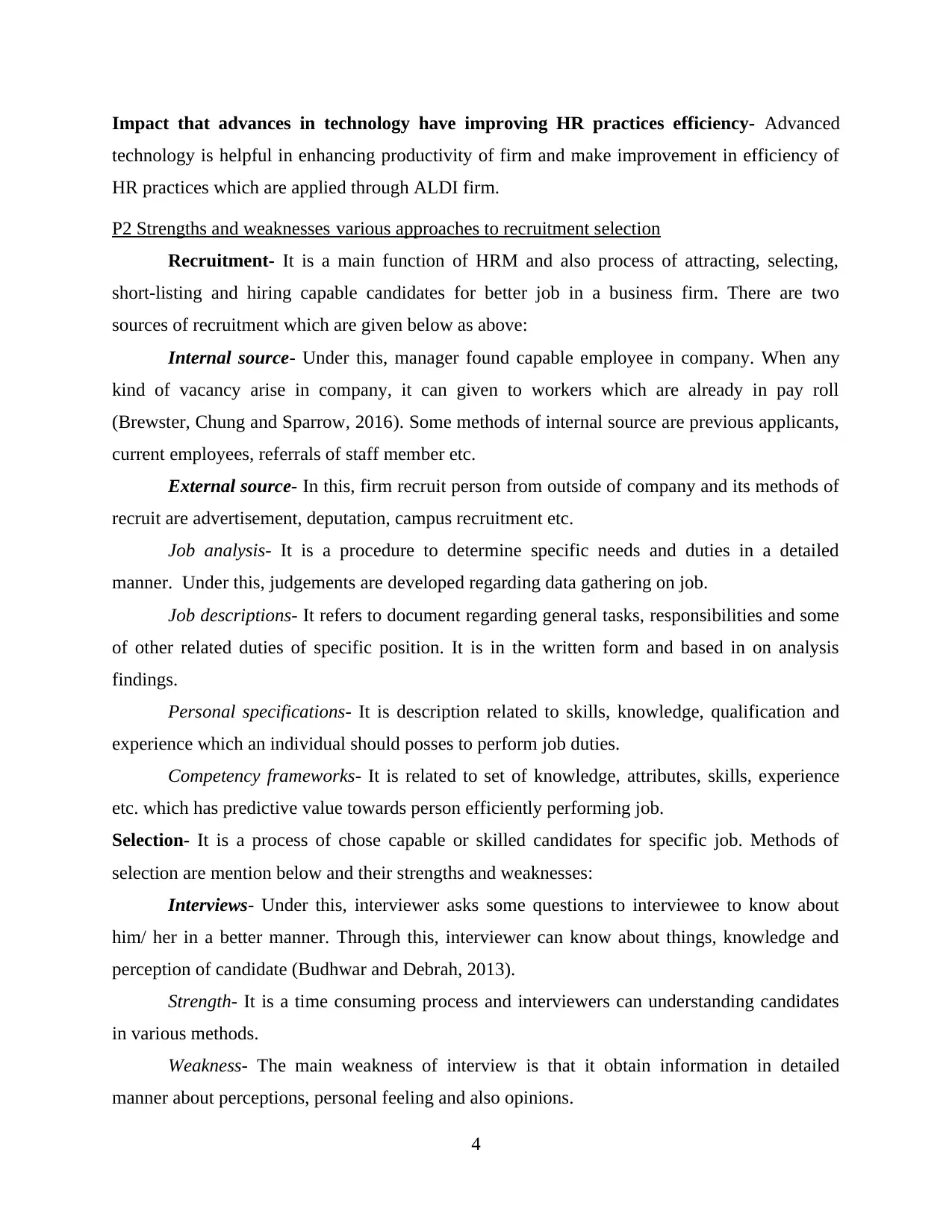
Impact that advances in technology have improving HR practices efficiency- Advanced
technology is helpful in enhancing productivity of firm and make improvement in efficiency of
HR practices which are applied through ALDI firm.
P2 Strengths and weaknesses various approaches to recruitment selection
Recruitment- It is a main function of HRM and also process of attracting, selecting,
short-listing and hiring capable candidates for better job in a business firm. There are two
sources of recruitment which are given below as above:
Internal source- Under this, manager found capable employee in company. When any
kind of vacancy arise in company, it can given to workers which are already in pay roll
(Brewster, Chung and Sparrow, 2016). Some methods of internal source are previous applicants,
current employees, referrals of staff member etc.
External source- In this, firm recruit person from outside of company and its methods of
recruit are advertisement, deputation, campus recruitment etc.
Job analysis- It is a procedure to determine specific needs and duties in a detailed
manner. Under this, judgements are developed regarding data gathering on job.
Job descriptions- It refers to document regarding general tasks, responsibilities and some
of other related duties of specific position. It is in the written form and based in on analysis
findings.
Personal specifications- It is description related to skills, knowledge, qualification and
experience which an individual should posses to perform job duties.
Competency frameworks- It is related to set of knowledge, attributes, skills, experience
etc. which has predictive value towards person efficiently performing job.
Selection- It is a process of chose capable or skilled candidates for specific job. Methods of
selection are mention below and their strengths and weaknesses:
Interviews- Under this, interviewer asks some questions to interviewee to know about
him/ her in a better manner. Through this, interviewer can know about things, knowledge and
perception of candidate (Budhwar and Debrah, 2013).
Strength- It is a time consuming process and interviewers can understanding candidates
in various methods.
Weakness- The main weakness of interview is that it obtain information in detailed
manner about perceptions, personal feeling and also opinions.
4
technology is helpful in enhancing productivity of firm and make improvement in efficiency of
HR practices which are applied through ALDI firm.
P2 Strengths and weaknesses various approaches to recruitment selection
Recruitment- It is a main function of HRM and also process of attracting, selecting,
short-listing and hiring capable candidates for better job in a business firm. There are two
sources of recruitment which are given below as above:
Internal source- Under this, manager found capable employee in company. When any
kind of vacancy arise in company, it can given to workers which are already in pay roll
(Brewster, Chung and Sparrow, 2016). Some methods of internal source are previous applicants,
current employees, referrals of staff member etc.
External source- In this, firm recruit person from outside of company and its methods of
recruit are advertisement, deputation, campus recruitment etc.
Job analysis- It is a procedure to determine specific needs and duties in a detailed
manner. Under this, judgements are developed regarding data gathering on job.
Job descriptions- It refers to document regarding general tasks, responsibilities and some
of other related duties of specific position. It is in the written form and based in on analysis
findings.
Personal specifications- It is description related to skills, knowledge, qualification and
experience which an individual should posses to perform job duties.
Competency frameworks- It is related to set of knowledge, attributes, skills, experience
etc. which has predictive value towards person efficiently performing job.
Selection- It is a process of chose capable or skilled candidates for specific job. Methods of
selection are mention below and their strengths and weaknesses:
Interviews- Under this, interviewer asks some questions to interviewee to know about
him/ her in a better manner. Through this, interviewer can know about things, knowledge and
perception of candidate (Budhwar and Debrah, 2013).
Strength- It is a time consuming process and interviewers can understanding candidates
in various methods.
Weakness- The main weakness of interview is that it obtain information in detailed
manner about perceptions, personal feeling and also opinions.
4
⊘ This is a preview!⊘
Do you want full access?
Subscribe today to unlock all pages.

Trusted by 1+ million students worldwide
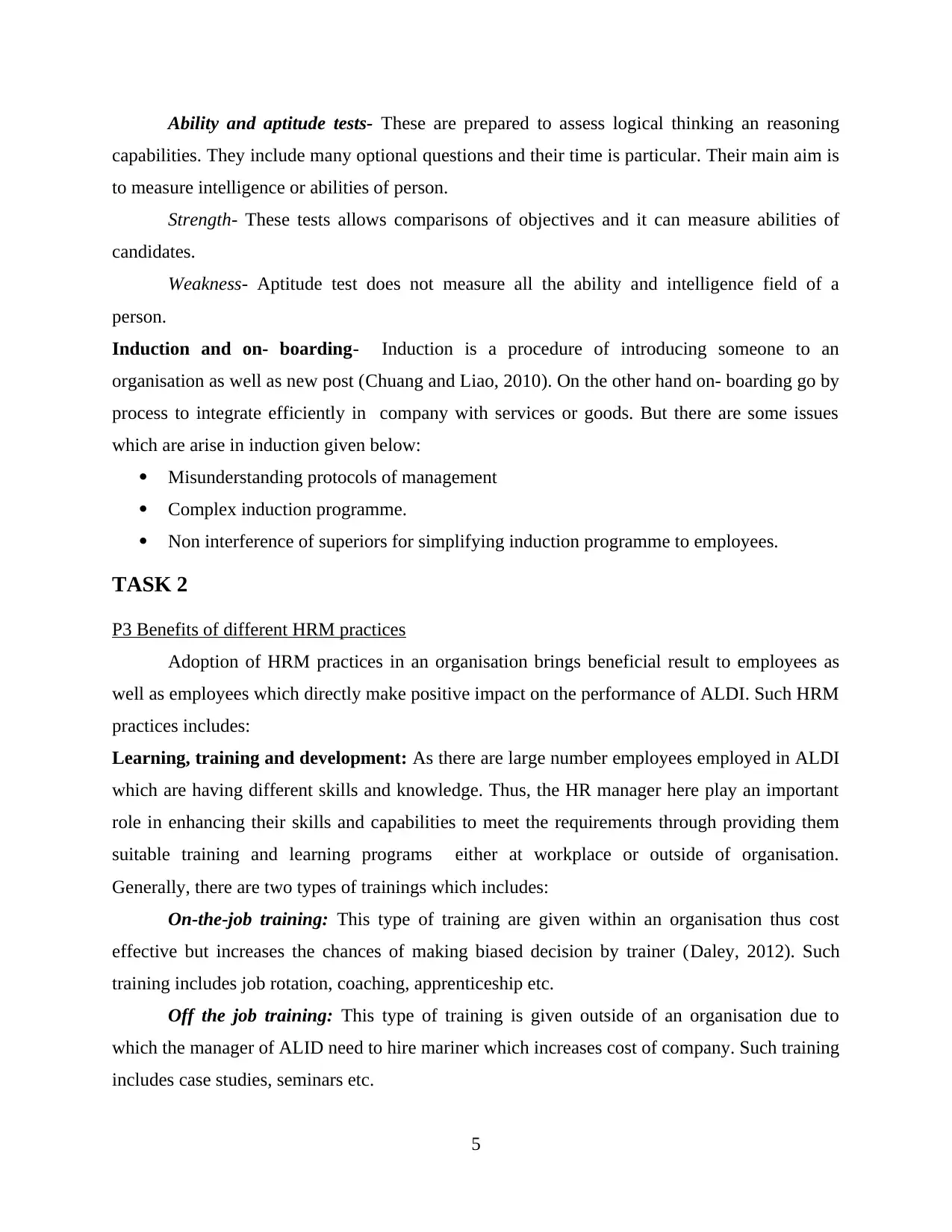
Ability and aptitude tests- These are prepared to assess logical thinking an reasoning
capabilities. They include many optional questions and their time is particular. Their main aim is
to measure intelligence or abilities of person.
Strength- These tests allows comparisons of objectives and it can measure abilities of
candidates.
Weakness- Aptitude test does not measure all the ability and intelligence field of a
person.
Induction and on- boarding- Induction is a procedure of introducing someone to an
organisation as well as new post (Chuang and Liao, 2010). On the other hand on- boarding go by
process to integrate efficiently in company with services or goods. But there are some issues
which are arise in induction given below:
Misunderstanding protocols of management
Complex induction programme.
Non interference of superiors for simplifying induction programme to employees.
TASK 2
P3 Benefits of different HRM practices
Adoption of HRM practices in an organisation brings beneficial result to employees as
well as employees which directly make positive impact on the performance of ALDI. Such HRM
practices includes:
Learning, training and development: As there are large number employees employed in ALDI
which are having different skills and knowledge. Thus, the HR manager here play an important
role in enhancing their skills and capabilities to meet the requirements through providing them
suitable training and learning programs either at workplace or outside of organisation.
Generally, there are two types of trainings which includes:
On-the-job training: This type of training are given within an organisation thus cost
effective but increases the chances of making biased decision by trainer (Daley, 2012). Such
training includes job rotation, coaching, apprenticeship etc.
Off the job training: This type of training is given outside of an organisation due to
which the manager of ALID need to hire mariner which increases cost of company. Such training
includes case studies, seminars etc.
5
capabilities. They include many optional questions and their time is particular. Their main aim is
to measure intelligence or abilities of person.
Strength- These tests allows comparisons of objectives and it can measure abilities of
candidates.
Weakness- Aptitude test does not measure all the ability and intelligence field of a
person.
Induction and on- boarding- Induction is a procedure of introducing someone to an
organisation as well as new post (Chuang and Liao, 2010). On the other hand on- boarding go by
process to integrate efficiently in company with services or goods. But there are some issues
which are arise in induction given below:
Misunderstanding protocols of management
Complex induction programme.
Non interference of superiors for simplifying induction programme to employees.
TASK 2
P3 Benefits of different HRM practices
Adoption of HRM practices in an organisation brings beneficial result to employees as
well as employees which directly make positive impact on the performance of ALDI. Such HRM
practices includes:
Learning, training and development: As there are large number employees employed in ALDI
which are having different skills and knowledge. Thus, the HR manager here play an important
role in enhancing their skills and capabilities to meet the requirements through providing them
suitable training and learning programs either at workplace or outside of organisation.
Generally, there are two types of trainings which includes:
On-the-job training: This type of training are given within an organisation thus cost
effective but increases the chances of making biased decision by trainer (Daley, 2012). Such
training includes job rotation, coaching, apprenticeship etc.
Off the job training: This type of training is given outside of an organisation due to
which the manager of ALID need to hire mariner which increases cost of company. Such training
includes case studies, seminars etc.
5
Paraphrase This Document
Need a fresh take? Get an instant paraphrase of this document with our AI Paraphraser
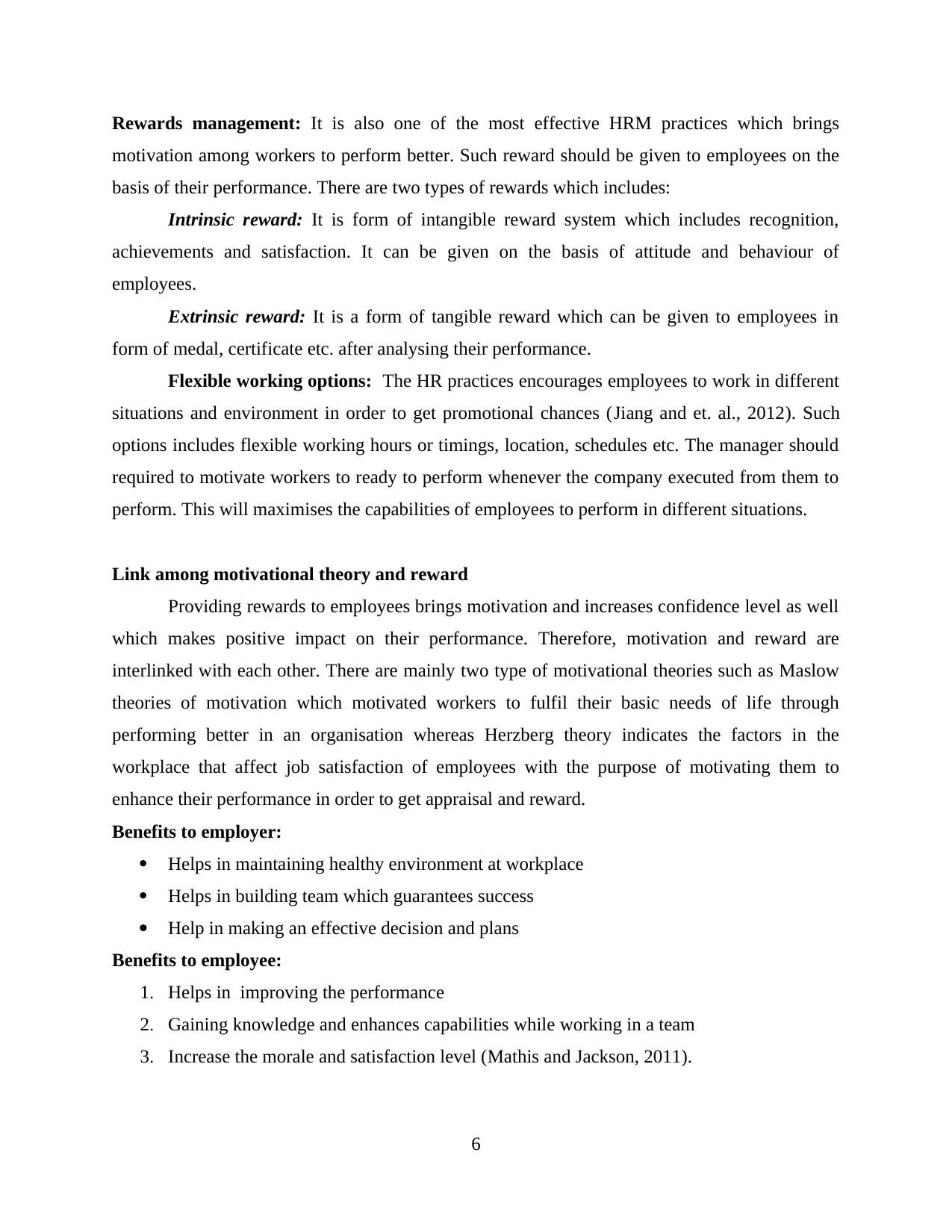
Rewards management: It is also one of the most effective HRM practices which brings
motivation among workers to perform better. Such reward should be given to employees on the
basis of their performance. There are two types of rewards which includes:
Intrinsic reward: It is form of intangible reward system which includes recognition,
achievements and satisfaction. It can be given on the basis of attitude and behaviour of
employees.
Extrinsic reward: It is a form of tangible reward which can be given to employees in
form of medal, certificate etc. after analysing their performance.
Flexible working options: The HR practices encourages employees to work in different
situations and environment in order to get promotional chances (Jiang and et. al., 2012). Such
options includes flexible working hours or timings, location, schedules etc. The manager should
required to motivate workers to ready to perform whenever the company executed from them to
perform. This will maximises the capabilities of employees to perform in different situations.
Link among motivational theory and reward
Providing rewards to employees brings motivation and increases confidence level as well
which makes positive impact on their performance. Therefore, motivation and reward are
interlinked with each other. There are mainly two type of motivational theories such as Maslow
theories of motivation which motivated workers to fulfil their basic needs of life through
performing better in an organisation whereas Herzberg theory indicates the factors in the
workplace that affect job satisfaction of employees with the purpose of motivating them to
enhance their performance in order to get appraisal and reward.
Benefits to employer:
Helps in maintaining healthy environment at workplace
Helps in building team which guarantees success
Help in making an effective decision and plans
Benefits to employee:
1. Helps in improving the performance
2. Gaining knowledge and enhances capabilities while working in a team
3. Increase the morale and satisfaction level (Mathis and Jackson, 2011).
6
motivation among workers to perform better. Such reward should be given to employees on the
basis of their performance. There are two types of rewards which includes:
Intrinsic reward: It is form of intangible reward system which includes recognition,
achievements and satisfaction. It can be given on the basis of attitude and behaviour of
employees.
Extrinsic reward: It is a form of tangible reward which can be given to employees in
form of medal, certificate etc. after analysing their performance.
Flexible working options: The HR practices encourages employees to work in different
situations and environment in order to get promotional chances (Jiang and et. al., 2012). Such
options includes flexible working hours or timings, location, schedules etc. The manager should
required to motivate workers to ready to perform whenever the company executed from them to
perform. This will maximises the capabilities of employees to perform in different situations.
Link among motivational theory and reward
Providing rewards to employees brings motivation and increases confidence level as well
which makes positive impact on their performance. Therefore, motivation and reward are
interlinked with each other. There are mainly two type of motivational theories such as Maslow
theories of motivation which motivated workers to fulfil their basic needs of life through
performing better in an organisation whereas Herzberg theory indicates the factors in the
workplace that affect job satisfaction of employees with the purpose of motivating them to
enhance their performance in order to get appraisal and reward.
Benefits to employer:
Helps in maintaining healthy environment at workplace
Helps in building team which guarantees success
Help in making an effective decision and plans
Benefits to employee:
1. Helps in improving the performance
2. Gaining knowledge and enhances capabilities while working in a team
3. Increase the morale and satisfaction level (Mathis and Jackson, 2011).
6
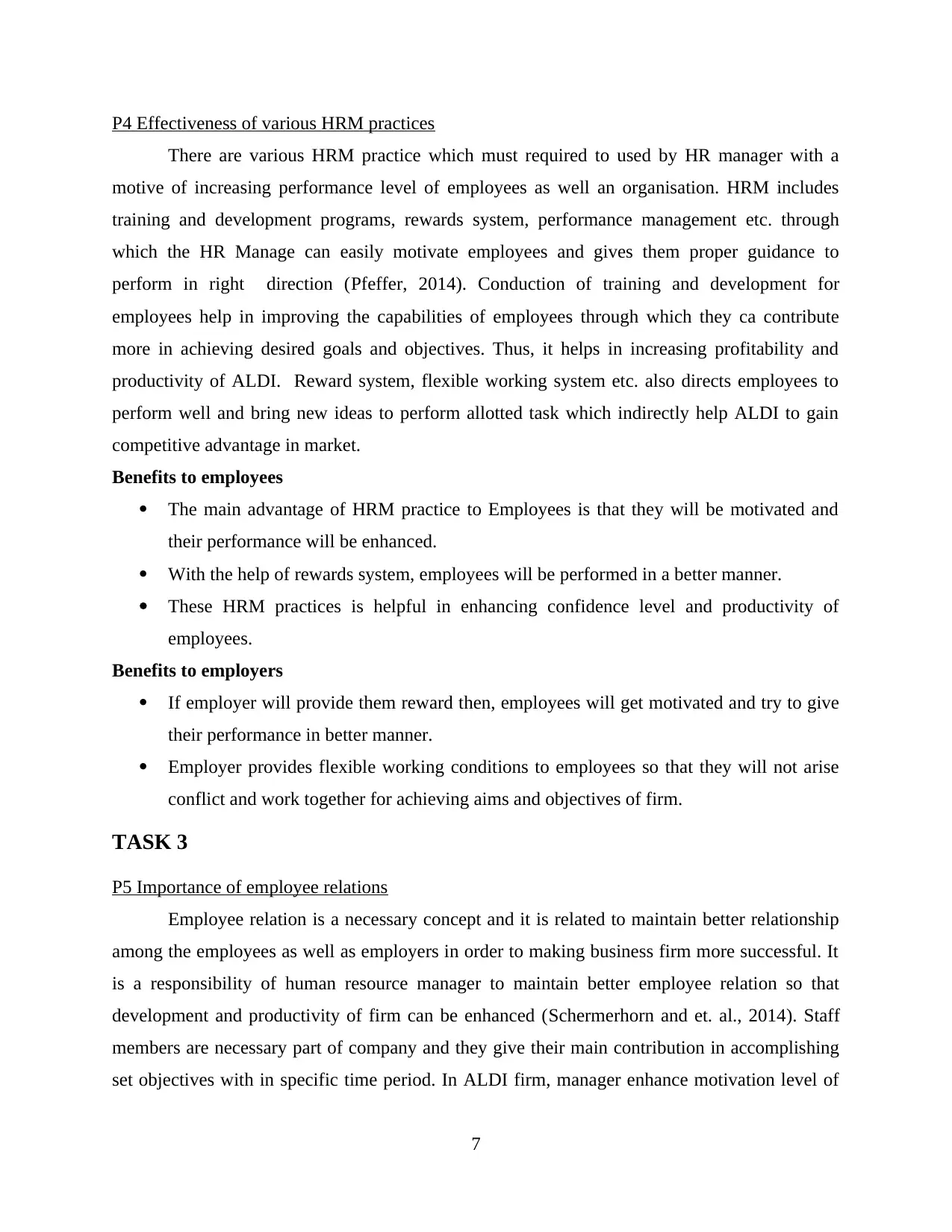
P4 Effectiveness of various HRM practices
There are various HRM practice which must required to used by HR manager with a
motive of increasing performance level of employees as well an organisation. HRM includes
training and development programs, rewards system, performance management etc. through
which the HR Manage can easily motivate employees and gives them proper guidance to
perform in right direction (Pfeffer, 2014). Conduction of training and development for
employees help in improving the capabilities of employees through which they ca contribute
more in achieving desired goals and objectives. Thus, it helps in increasing profitability and
productivity of ALDI. Reward system, flexible working system etc. also directs employees to
perform well and bring new ideas to perform allotted task which indirectly help ALDI to gain
competitive advantage in market.
Benefits to employees
The main advantage of HRM practice to Employees is that they will be motivated and
their performance will be enhanced.
With the help of rewards system, employees will be performed in a better manner.
These HRM practices is helpful in enhancing confidence level and productivity of
employees.
Benefits to employers
If employer will provide them reward then, employees will get motivated and try to give
their performance in better manner.
Employer provides flexible working conditions to employees so that they will not arise
conflict and work together for achieving aims and objectives of firm.
TASK 3
P5 Importance of employee relations
Employee relation is a necessary concept and it is related to maintain better relationship
among the employees as well as employers in order to making business firm more successful. It
is a responsibility of human resource manager to maintain better employee relation so that
development and productivity of firm can be enhanced (Schermerhorn and et. al., 2014). Staff
members are necessary part of company and they give their main contribution in accomplishing
set objectives with in specific time period. In ALDI firm, manager enhance motivation level of
7
There are various HRM practice which must required to used by HR manager with a
motive of increasing performance level of employees as well an organisation. HRM includes
training and development programs, rewards system, performance management etc. through
which the HR Manage can easily motivate employees and gives them proper guidance to
perform in right direction (Pfeffer, 2014). Conduction of training and development for
employees help in improving the capabilities of employees through which they ca contribute
more in achieving desired goals and objectives. Thus, it helps in increasing profitability and
productivity of ALDI. Reward system, flexible working system etc. also directs employees to
perform well and bring new ideas to perform allotted task which indirectly help ALDI to gain
competitive advantage in market.
Benefits to employees
The main advantage of HRM practice to Employees is that they will be motivated and
their performance will be enhanced.
With the help of rewards system, employees will be performed in a better manner.
These HRM practices is helpful in enhancing confidence level and productivity of
employees.
Benefits to employers
If employer will provide them reward then, employees will get motivated and try to give
their performance in better manner.
Employer provides flexible working conditions to employees so that they will not arise
conflict and work together for achieving aims and objectives of firm.
TASK 3
P5 Importance of employee relations
Employee relation is a necessary concept and it is related to maintain better relationship
among the employees as well as employers in order to making business firm more successful. It
is a responsibility of human resource manager to maintain better employee relation so that
development and productivity of firm can be enhanced (Schermerhorn and et. al., 2014). Staff
members are necessary part of company and they give their main contribution in accomplishing
set objectives with in specific time period. In ALDI firm, manager enhance motivation level of
7
⊘ This is a preview!⊘
Do you want full access?
Subscribe today to unlock all pages.

Trusted by 1+ million students worldwide
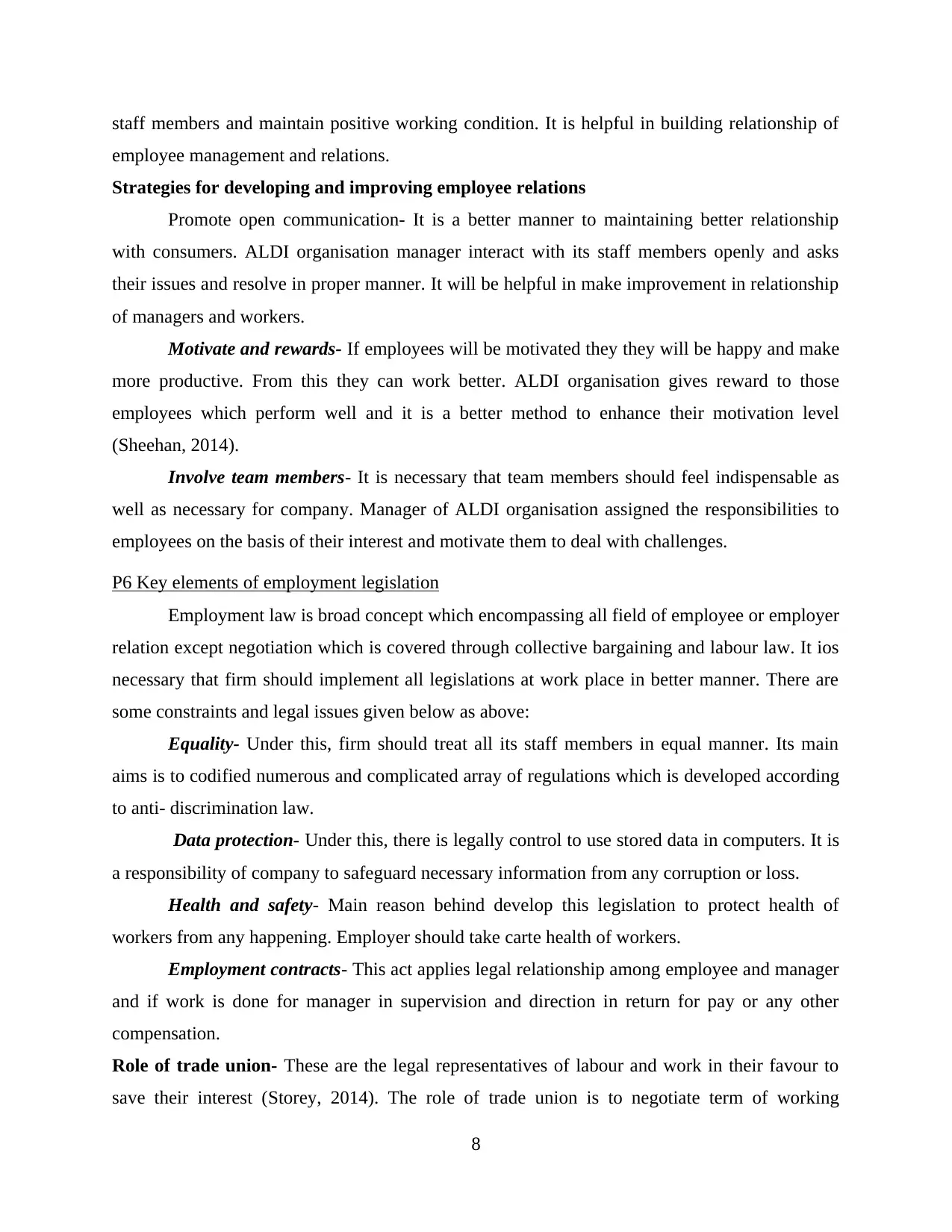
staff members and maintain positive working condition. It is helpful in building relationship of
employee management and relations.
Strategies for developing and improving employee relations
Promote open communication- It is a better manner to maintaining better relationship
with consumers. ALDI organisation manager interact with its staff members openly and asks
their issues and resolve in proper manner. It will be helpful in make improvement in relationship
of managers and workers.
Motivate and rewards- If employees will be motivated they they will be happy and make
more productive. From this they can work better. ALDI organisation gives reward to those
employees which perform well and it is a better method to enhance their motivation level
(Sheehan, 2014).
Involve team members- It is necessary that team members should feel indispensable as
well as necessary for company. Manager of ALDI organisation assigned the responsibilities to
employees on the basis of their interest and motivate them to deal with challenges.
P6 Key elements of employment legislation
Employment law is broad concept which encompassing all field of employee or employer
relation except negotiation which is covered through collective bargaining and labour law. It ios
necessary that firm should implement all legislations at work place in better manner. There are
some constraints and legal issues given below as above:
Equality- Under this, firm should treat all its staff members in equal manner. Its main
aims is to codified numerous and complicated array of regulations which is developed according
to anti- discrimination law.
Data protection- Under this, there is legally control to use stored data in computers. It is
a responsibility of company to safeguard necessary information from any corruption or loss.
Health and safety- Main reason behind develop this legislation to protect health of
workers from any happening. Employer should take carte health of workers.
Employment contracts- This act applies legal relationship among employee and manager
and if work is done for manager in supervision and direction in return for pay or any other
compensation.
Role of trade union- These are the legal representatives of labour and work in their favour to
save their interest (Storey, 2014). The role of trade union is to negotiate term of working
8
employee management and relations.
Strategies for developing and improving employee relations
Promote open communication- It is a better manner to maintaining better relationship
with consumers. ALDI organisation manager interact with its staff members openly and asks
their issues and resolve in proper manner. It will be helpful in make improvement in relationship
of managers and workers.
Motivate and rewards- If employees will be motivated they they will be happy and make
more productive. From this they can work better. ALDI organisation gives reward to those
employees which perform well and it is a better method to enhance their motivation level
(Sheehan, 2014).
Involve team members- It is necessary that team members should feel indispensable as
well as necessary for company. Manager of ALDI organisation assigned the responsibilities to
employees on the basis of their interest and motivate them to deal with challenges.
P6 Key elements of employment legislation
Employment law is broad concept which encompassing all field of employee or employer
relation except negotiation which is covered through collective bargaining and labour law. It ios
necessary that firm should implement all legislations at work place in better manner. There are
some constraints and legal issues given below as above:
Equality- Under this, firm should treat all its staff members in equal manner. Its main
aims is to codified numerous and complicated array of regulations which is developed according
to anti- discrimination law.
Data protection- Under this, there is legally control to use stored data in computers. It is
a responsibility of company to safeguard necessary information from any corruption or loss.
Health and safety- Main reason behind develop this legislation to protect health of
workers from any happening. Employer should take carte health of workers.
Employment contracts- This act applies legal relationship among employee and manager
and if work is done for manager in supervision and direction in return for pay or any other
compensation.
Role of trade union- These are the legal representatives of labour and work in their favour to
save their interest (Storey, 2014). The role of trade union is to negotiate term of working
8
Paraphrase This Document
Need a fresh take? Get an instant paraphrase of this document with our AI Paraphraser
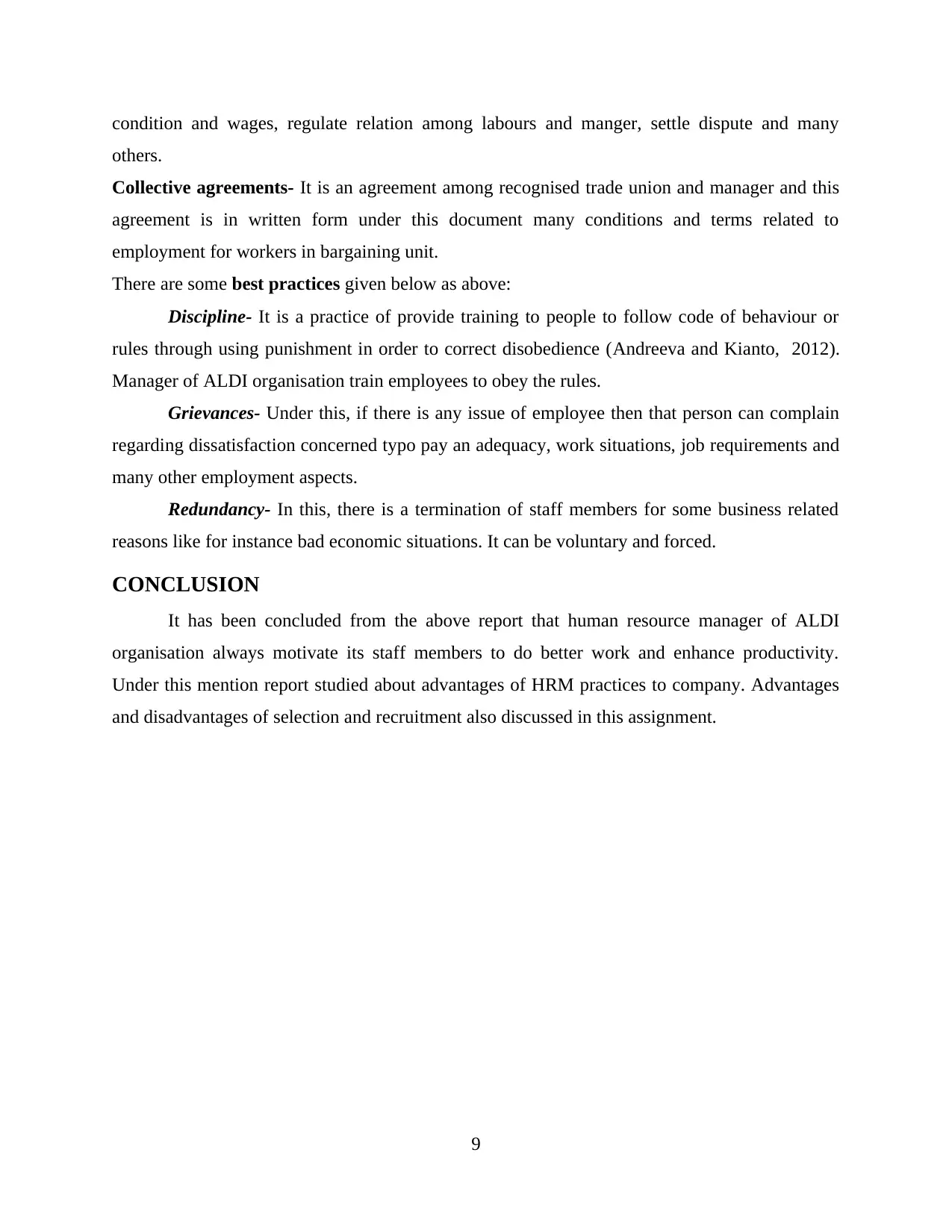
condition and wages, regulate relation among labours and manger, settle dispute and many
others.
Collective agreements- It is an agreement among recognised trade union and manager and this
agreement is in written form under this document many conditions and terms related to
employment for workers in bargaining unit.
There are some best practices given below as above:
Discipline- It is a practice of provide training to people to follow code of behaviour or
rules through using punishment in order to correct disobedience (Andreeva and Kianto, 2012).
Manager of ALDI organisation train employees to obey the rules.
Grievances- Under this, if there is any issue of employee then that person can complain
regarding dissatisfaction concerned typo pay an adequacy, work situations, job requirements and
many other employment aspects.
Redundancy- In this, there is a termination of staff members for some business related
reasons like for instance bad economic situations. It can be voluntary and forced.
CONCLUSION
It has been concluded from the above report that human resource manager of ALDI
organisation always motivate its staff members to do better work and enhance productivity.
Under this mention report studied about advantages of HRM practices to company. Advantages
and disadvantages of selection and recruitment also discussed in this assignment.
9
others.
Collective agreements- It is an agreement among recognised trade union and manager and this
agreement is in written form under this document many conditions and terms related to
employment for workers in bargaining unit.
There are some best practices given below as above:
Discipline- It is a practice of provide training to people to follow code of behaviour or
rules through using punishment in order to correct disobedience (Andreeva and Kianto, 2012).
Manager of ALDI organisation train employees to obey the rules.
Grievances- Under this, if there is any issue of employee then that person can complain
regarding dissatisfaction concerned typo pay an adequacy, work situations, job requirements and
many other employment aspects.
Redundancy- In this, there is a termination of staff members for some business related
reasons like for instance bad economic situations. It can be voluntary and forced.
CONCLUSION
It has been concluded from the above report that human resource manager of ALDI
organisation always motivate its staff members to do better work and enhance productivity.
Under this mention report studied about advantages of HRM practices to company. Advantages
and disadvantages of selection and recruitment also discussed in this assignment.
9
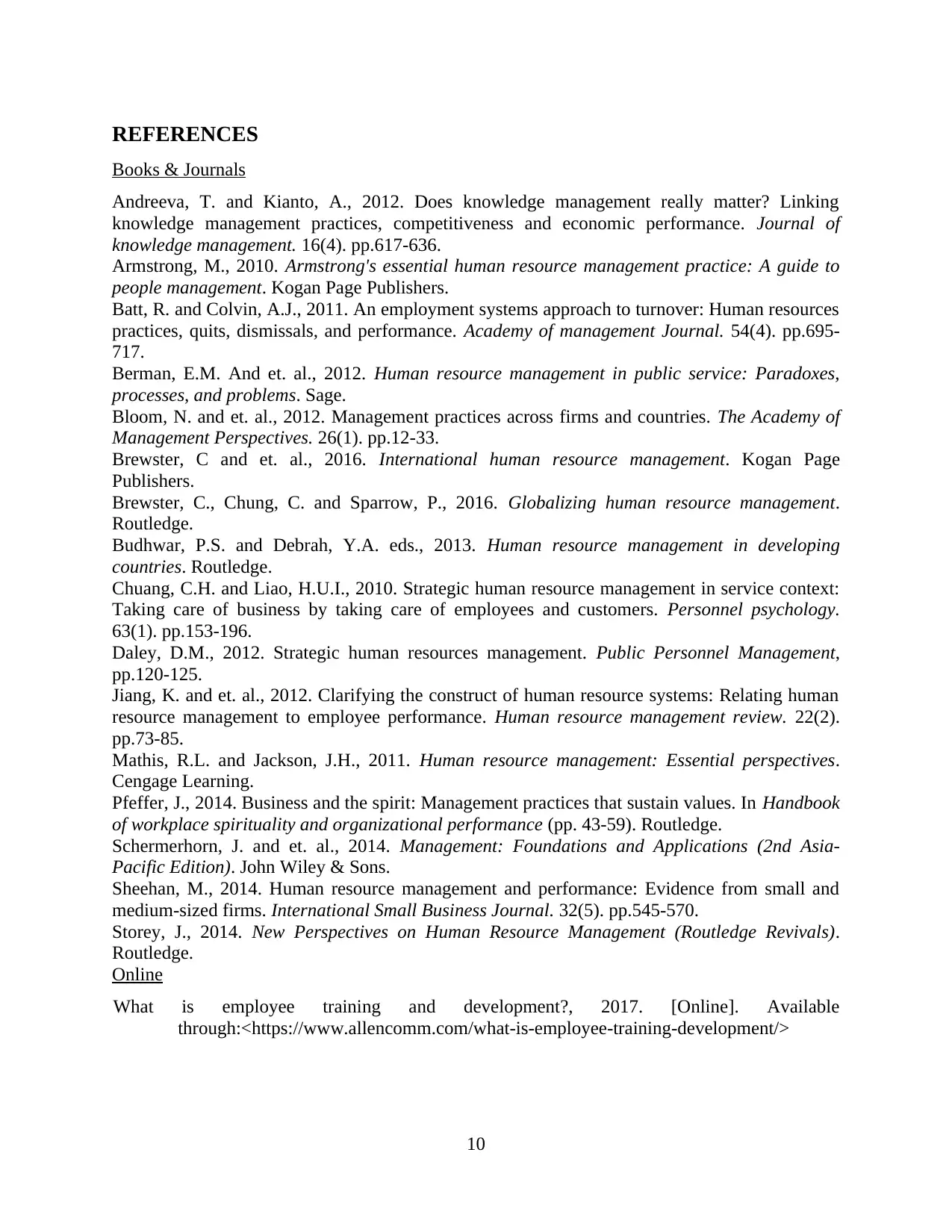
REFERENCES
Books & Journals
Andreeva, T. and Kianto, A., 2012. Does knowledge management really matter? Linking
knowledge management practices, competitiveness and economic performance. Journal of
knowledge management. 16(4). pp.617-636.
Armstrong, M., 2010. Armstrong's essential human resource management practice: A guide to
people management. Kogan Page Publishers.
Batt, R. and Colvin, A.J., 2011. An employment systems approach to turnover: Human resources
practices, quits, dismissals, and performance. Academy of management Journal. 54(4). pp.695-
717.
Berman, E.M. And et. al., 2012. Human resource management in public service: Paradoxes,
processes, and problems. Sage.
Bloom, N. and et. al., 2012. Management practices across firms and countries. The Academy of
Management Perspectives. 26(1). pp.12-33.
Brewster, C and et. al., 2016. International human resource management. Kogan Page
Publishers.
Brewster, C., Chung, C. and Sparrow, P., 2016. Globalizing human resource management.
Routledge.
Budhwar, P.S. and Debrah, Y.A. eds., 2013. Human resource management in developing
countries. Routledge.
Chuang, C.H. and Liao, H.U.I., 2010. Strategic human resource management in service context:
Taking care of business by taking care of employees and customers. Personnel psychology.
63(1). pp.153-196.
Daley, D.M., 2012. Strategic human resources management. Public Personnel Management,
pp.120-125.
Jiang, K. and et. al., 2012. Clarifying the construct of human resource systems: Relating human
resource management to employee performance. Human resource management review. 22(2).
pp.73-85.
Mathis, R.L. and Jackson, J.H., 2011. Human resource management: Essential perspectives.
Cengage Learning.
Pfeffer, J., 2014. Business and the spirit: Management practices that sustain values. In Handbook
of workplace spirituality and organizational performance (pp. 43-59). Routledge.
Schermerhorn, J. and et. al., 2014. Management: Foundations and Applications (2nd Asia-
Pacific Edition). John Wiley & Sons.
Sheehan, M., 2014. Human resource management and performance: Evidence from small and
medium-sized firms. International Small Business Journal. 32(5). pp.545-570.
Storey, J., 2014. New Perspectives on Human Resource Management (Routledge Revivals).
Routledge.
Online
What is employee training and development?, 2017. [Online]. Available
through:<https://www.allencomm.com/what-is-employee-training-development/>
10
Books & Journals
Andreeva, T. and Kianto, A., 2012. Does knowledge management really matter? Linking
knowledge management practices, competitiveness and economic performance. Journal of
knowledge management. 16(4). pp.617-636.
Armstrong, M., 2010. Armstrong's essential human resource management practice: A guide to
people management. Kogan Page Publishers.
Batt, R. and Colvin, A.J., 2011. An employment systems approach to turnover: Human resources
practices, quits, dismissals, and performance. Academy of management Journal. 54(4). pp.695-
717.
Berman, E.M. And et. al., 2012. Human resource management in public service: Paradoxes,
processes, and problems. Sage.
Bloom, N. and et. al., 2012. Management practices across firms and countries. The Academy of
Management Perspectives. 26(1). pp.12-33.
Brewster, C and et. al., 2016. International human resource management. Kogan Page
Publishers.
Brewster, C., Chung, C. and Sparrow, P., 2016. Globalizing human resource management.
Routledge.
Budhwar, P.S. and Debrah, Y.A. eds., 2013. Human resource management in developing
countries. Routledge.
Chuang, C.H. and Liao, H.U.I., 2010. Strategic human resource management in service context:
Taking care of business by taking care of employees and customers. Personnel psychology.
63(1). pp.153-196.
Daley, D.M., 2012. Strategic human resources management. Public Personnel Management,
pp.120-125.
Jiang, K. and et. al., 2012. Clarifying the construct of human resource systems: Relating human
resource management to employee performance. Human resource management review. 22(2).
pp.73-85.
Mathis, R.L. and Jackson, J.H., 2011. Human resource management: Essential perspectives.
Cengage Learning.
Pfeffer, J., 2014. Business and the spirit: Management practices that sustain values. In Handbook
of workplace spirituality and organizational performance (pp. 43-59). Routledge.
Schermerhorn, J. and et. al., 2014. Management: Foundations and Applications (2nd Asia-
Pacific Edition). John Wiley & Sons.
Sheehan, M., 2014. Human resource management and performance: Evidence from small and
medium-sized firms. International Small Business Journal. 32(5). pp.545-570.
Storey, J., 2014. New Perspectives on Human Resource Management (Routledge Revivals).
Routledge.
Online
What is employee training and development?, 2017. [Online]. Available
through:<https://www.allencomm.com/what-is-employee-training-development/>
10
⊘ This is a preview!⊘
Do you want full access?
Subscribe today to unlock all pages.

Trusted by 1+ million students worldwide
1 out of 13
Related Documents
Your All-in-One AI-Powered Toolkit for Academic Success.
+13062052269
info@desklib.com
Available 24*7 on WhatsApp / Email
![[object Object]](/_next/static/media/star-bottom.7253800d.svg)
Unlock your academic potential
Copyright © 2020–2025 A2Z Services. All Rights Reserved. Developed and managed by ZUCOL.




